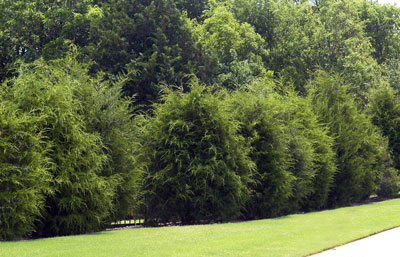Question of the Week Number 2: December 6, 2018
“We live next to a large open area. What is the best way to stop the winter wind?”

Eastern redcedars make effective windbreak and privacy screen. They’re well suited to Texas and relatively quick-growing as long as they’re given supplemental water on a regular basis.
Evergreen plants are obviously going to be the solution. However, except when they’re used in the Piney Woods of East Texas where pines are native, pines run into disease and environmental problems farther west.
The same things have happened to Leyland, Italian and Arizona cypresses and a few of our popular junipers (Blue Point, Spartan and some of the extremely columnar types).
My recommendation has always been the use of native junipers. For big parts of Texas that would be eastern redcedar (Juniperus virginiana) or Ashe juniper (Juniperus ashei). Plant these in irregular sweeps 18 to 22 feet apart. Start with small plants (knee-high). They establish more quickly and give a dense screen more dependably. Larger plants have a much higher mortality rate. Also, if you plant these too close together they will denude one another. Keep them watered well, and apply a high-nitrogen lawn food to foster best growth.
Live oaks would be the best tree to use for variety. Use them in groupings to break up long rows of the junipers (assuming you have large rural property). Again, give them ample room to spread. It’s best to plant them 40 feet apart so their outer branches can extend back to the earth.
In smaller spaces you can use the large hollies such as Nellie R. Stevens, yaupon and Oakland hollies as your wind-breaking plants. Plant them 8 to 10 or 12 feet apart so they can grow and fill in. It’s always best to plant in clusters and groupings rather than long, straight rows.
The parts of my answer that might surprise you are:
1. When I challenge you to whether you really want a windbreak in the first place. Certainly, winter winds in Texas can blow really cold, but it also gets extremely hot for more days in the summer here in Texas. If you stop the movement of air in the winter, you may be creating a hot box in summer.
and…
2. When you find out how far away from your house the windbreak really needs to be to be effective. Smoke bomb studies have shown that for maximum effectiveness a windbreak needs to be 1-1/2 times the height of a building to block the flow of wind toward it, and that the windbreak needs to be 10 to 12 times as far away from the house as the windbreak is tall. That means it may need to be 250-300 feet away from a one-story house, and that’s not going to be practical.
Those are just a couple of things to remember when you start longing for windbreaks.
